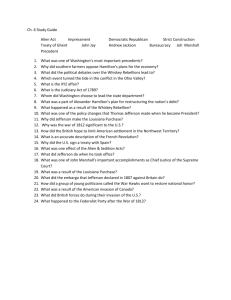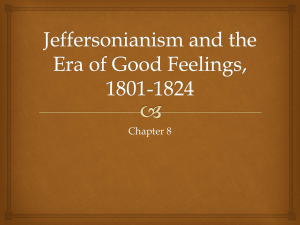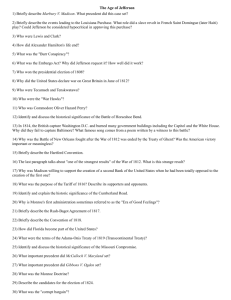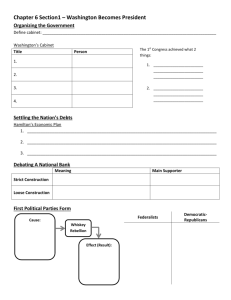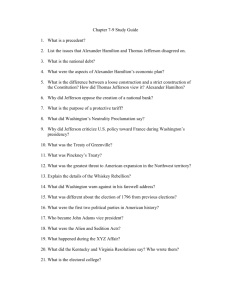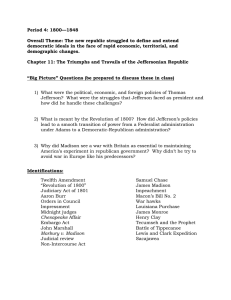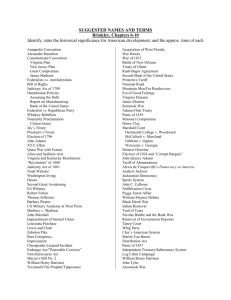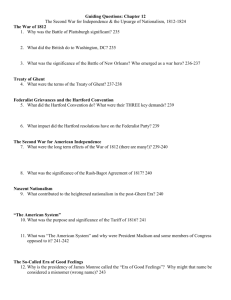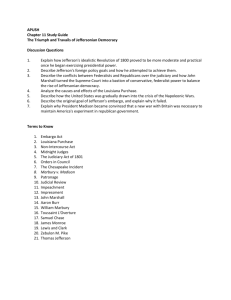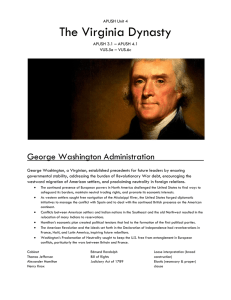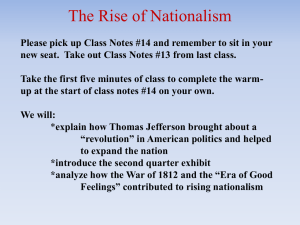Unit 4- The Age of Jefferson
advertisement
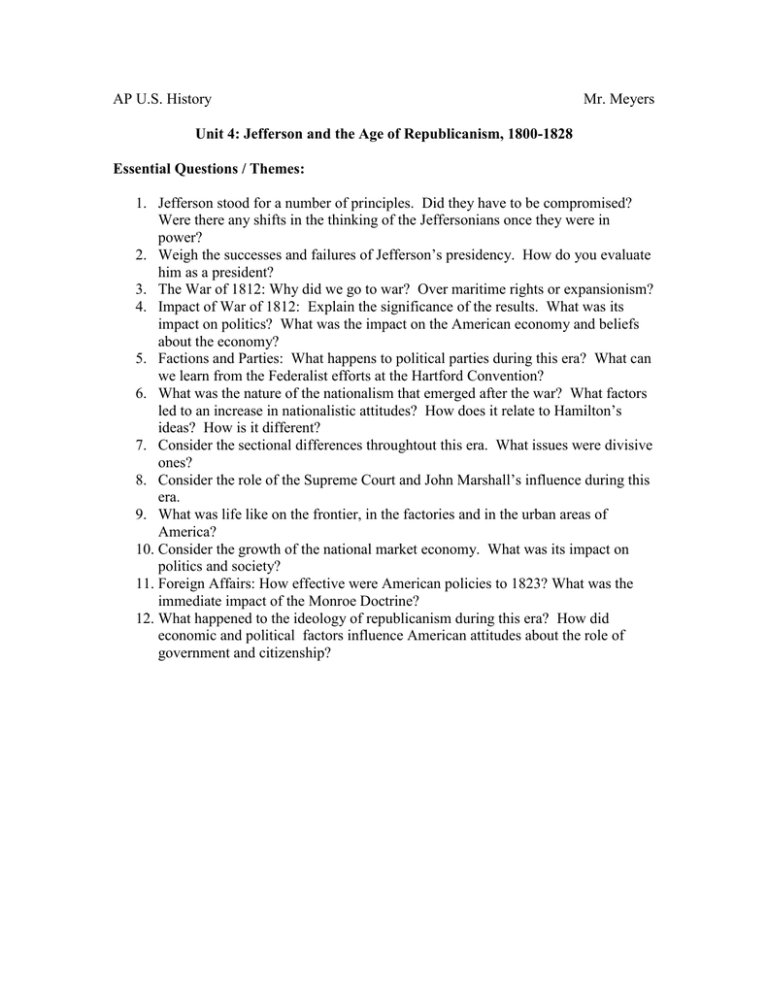
AP U.S. History Mr. Meyers Unit 4: Jefferson and the Age of Republicanism, 1800-1828 Essential Questions / Themes: 1. Jefferson stood for a number of principles. Did they have to be compromised? Were there any shifts in the thinking of the Jeffersonians once they were in power? 2. Weigh the successes and failures of Jefferson’s presidency. How do you evaluate him as a president? 3. The War of 1812: Why did we go to war? Over maritime rights or expansionism? 4. Impact of War of 1812: Explain the significance of the results. What was its impact on politics? What was the impact on the American economy and beliefs about the economy? 5. Factions and Parties: What happens to political parties during this era? What can we learn from the Federalist efforts at the Hartford Convention? 6. What was the nature of the nationalism that emerged after the war? What factors led to an increase in nationalistic attitudes? How does it relate to Hamilton’s ideas? How is it different? 7. Consider the sectional differences throughtout this era. What issues were divisive ones? 8. Consider the role of the Supreme Court and John Marshall’s influence during this era. 9. What was life like on the frontier, in the factories and in the urban areas of America? 10. Consider the growth of the national market economy. What was its impact on politics and society? 11. Foreign Affairs: How effective were American policies to 1823? What was the immediate impact of the Monroe Doctrine? 12. What happened to the ideology of republicanism during this era? How did economic and political factors influence American attitudes about the role of government and citizenship? Syllabus: Wednesday, 10-12 Thursday, 10-13 Thomas Jefferson Work Day Text 231-240 Notes and Chart Thomas Jefferson Friday, 10-14 Evaluating Jefferson’s Domestic and Foreign Policy Monday, 10-17 The War of 1812 Expansion and Indian Policy America’s Market Economy Tuesday, 10-18 Wednesday, 10-19 Thursday, 10-20 Nationalism, the Supreme Court and U.S. Foreign Policy Exam (Objective Only) Time Magazine Article and T-Chart: Jefferson as Jeffersonian or Hamiltonian Text 240-251 Finish Chart Text 251-258 Document: The Hartford Convention (What passages appear to contradict Federalist ideology?) Text 269-278 (ALL PAGES) What can we learn from a “Mill Girl?” Text 278-284 Reading: Marshall’s Key Decisions Based on his rulings, what was his political / judicial philosophy? Text 284-287 Reading: Monroe Doctrine Have a great three-day weekend! Study Tools Chapter 8 northwest frontier Samuel Slater Jeffersonian reforms James Monroe Marshall Marbury v. Madison impeachment Burr Burr treason trial continental system Embargo Act of 1807 War Hawks Oliver Perry: Put-in-Bay Tecumseh Robert Fulton Louisiana Purchase Louisiana Government Act William Clark mercantile New England Albert Gallatin Robert Livingston Meriwether Lewis the Barbary War John judicial review Yazoo controversy Samuel Chase Fletcher v. Peck Aaron Slave Trade Act of 1807 Berlin and Milan Decrees Non-Intercourse Act of 1809 William Henry Harrison Tecumseh John Calhoun Battle of the Thames River Burning of Washington Francis Scott Key Orders in Council the Chesapeake incident Macon’s Bill Number 2 Battle of Tippecanoe Henry Clay Battle of Plattsburg Seige of Baltimore Battle of New Orleans Convention Andrew Jackson Treaty of Ghent The Hartford Chapter 9: As you read Chapter 9, consider...how many of the items below relate to six issues that confront Americans during this era: the Bank, Land policy, Internal improvements, Indian Removal, Slavery and the Tariff = B L I I S T pp. 261-269 Impact of War of 1812 Jackson’s raid on Florida John Quincy Adams Adams-Onis Tready (also known as: The Florida Purchase Treaty and Transcontinental Treaty) “mountain men” John Jacob Astor Black Hawk/Black Hawk’s War Five Civilized Tribes land policy - speculators squatters - preemption rights frontier culture: self reliance and mutual aid NOT MENTIONED IN TEXT: Treaties negotiated with England following the Treaty of Ghent regarding U.S.Canadian boundaries: Rush Bagot Treaty: (Great Lakes boundaries) Convention of 1818: (boundary between Lake of the Woods and Rockies) pp. 269-278 national market economy Robert Fulton - steamboat rise of cotton in South U.S. putting out system Company Lowell, Appleton and Jackson National Road Erie Canal specie flatboats staple or cash crops Second Bank of the factory system Boston Manufacturing Waltham and Lowell Mills pp. 278-284 Madison’s Dec. 15 proposals Henry Clay’s American System Second Bank of the U.S. Internal Improvements: Madison’s veto (The actual name of the bill was the Bonus Bill) James Monroe “era of good feelings” Panic of 1819 Missouri Compromise Tallmadge Amendment John Marshall McCullough v. Maryland Dartmouth College v.Woodward Gibbons v. Ogden pp. 284-287 Monroe Doctrine Canning Grand Alliance role of Sec. of State John Q. Adams George
